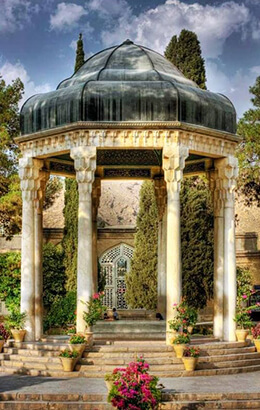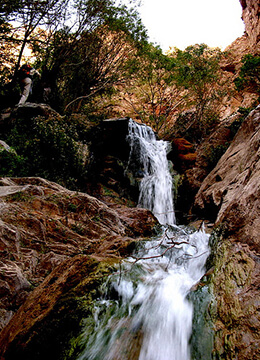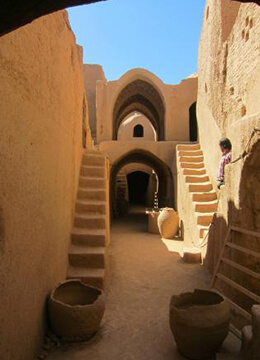Shiraz
Shiraz
Shiraz is the capital city of Fars province and a treasure trove of Persian culture. Shiraz is located in the southwest of Iran on the “Rudkhaneye Khoshk” (The Dry River) seasonal river. It has a moderate climate and has been a regional trade center for over a thousand years. Shiraz is one of the oldest cities of ancient Persia. It is also the former capital of Iran, during the Zand dynasty (1747-79 A.C), and also the celebrated birthplace of the great Persian poets, Hafiz and Saadi.
Don’t hesitate to talk to people, most of the Shirazies speak English well enough to talk to you, answer your questions and guide you in the city; just like all Iranian, people of Shiraz are well known for their hospitality.
The Tomb of Hafez, Hafezieh, Mausoleum of Hafez. Hafez (1324-1391), the master of Persian sonnet and the literary giant feature of the 14th century in the west and central Asia, born in Shiraz, lived all his life there, and buried in a garden known after him as the Hafezieh. The extraordinary popularity and the wide appeal of this great poet among all people who speaks Farsi or read the translations of his poems world widely, make his tomb a cherished place. A flight of stone steps reaches to the tomb under a tiled cupola resembling a dervish’s hat. The tombstone is beautifully inscribed with two of Hafez’s poems.
The Tomb of Saadi, Mausoleum of Saadi. Here is the earthly remains of one of the Iranian greatest poets Saadi. Abu-Muhammad Muslih al-Din bin Abdallah Shirazi, better known by his pen-name Saadi, also known as Saadi of Shiraz, was a major Persian poet and prose writer of the medieval period. He is recognized for the quality of his writings and for the depth of his social and moral thoughts. In 1808 AD Karim Khan Zand, the establisher of Zand dynasty, renovated the mausoleum. The tomb was rebuilt in the early 1950’s. The porch with its tall columns of pinkish marble is a traditional feature of Iranian architecture.
Arg of Karim Khan. It was formerly a prison, but now an architectural wonder on exhibit. The design of the citadel combines military and residential architecture, for it was the home of Karim Khan and the military center of the dynasty. Tile works depicting legendary tales were added at the entrance gate of the citadel during the Qajar dynasty.
Afif Abad Garden (Bagh-e-Afifabad), a garden and houses owned by the Ghavami family. It contains a former royal mansion, a historical weapons museum, and a Persian garden that is one of the oldest gardens in Shiraz, all open to the public.
Eram Garden (Bagh-e-Eram) This beautiful complex contains a vast network of gardens, as well as a colorful Palace and a system of small artificial rivers flowing throughout the entire area. It’s recommended to visit this garden in a sunny day.
Narenjestan-e-Qavam, is both traditional and historical house. It was built in the mid-19th century by Mirza Ibrahim Khan. The Qavam Narenjestan preserves the elegance and refinement enjoyed by the upper class families during the 19th century. The mirrored porch was a focal point of the house, overlooking onto gardens lined with date palms and flowers. The house today is a museum open to the public.
Nasir-al-Mulk Mosque. It was built during the Qajar era. The mosque has extensively colored glass in its façade. Better to go in the morning to see the colorful shades.
Vakil Mosque, was built between 1751 and 1773, during the Zand dynasty; and was restored in the 19th century in the Qajar dynasty.
Vakil Bath, is an old public bath in Shiraz; which was a part of the royal district constructed during Karim Khan Zand’s reign.
Vakil Bazaar, has several beautiful courtyards, caravanserais, bath houses, and old shops where hundreds of vendor are housed, which makes it deemed among the best places in Shiraz to buy all kinds of Persian rugs, spices, copper handicrafts and antiques.
Saray-e-Moshir, is a caravansary at the south entrance of Bazaar Vakil, which now functions as exhibition space for Iranian handicrafts.
Shah Cheragh, Sayed Amir Ahmad, known as Shah-e-Cheragh, the brother of Imam Reza (A.S), came to Shiraz in the latter half of the 8th century. He passed away in the city and his tomb is now a respected place for pilgrimage. The structure, tile work and the dome of the mausoleum have been rebuilt several times over the centuries. The tomb, the beautiful silver doors and the exquisite mirror work are the handicrafts of masters and contemporary artists of Shiraz.
Palace of Ardashir, Abesh Khatoon Tomb, Sayed Taj-e-din Gharib Tomb, Sheikh Roozbahan Tomb, Khan School, and the Christians Church are other places available to visit in the city.
Qur’an Gate, is the city’s main entrance. The original gate was built as an ornamental decoration about 1000 years ago, but this was replaced 60 years ago by new gate, which is considered one of the finest architectural designs in Iran and has won numerous awards. The tomb of Khajooyeh Kermanee, a famous poet is also located there. Hidden in the alleys on the hill-side are numerous restaurants that serve the finest chelo kebab.
Takht-e-Jamshid (Persepolis), was the capital of Achaemenes King Cyrus the Great, the ceremonial capital of his successor, Darius, and his son Xerxes. Iranians call it Takht-e Jamshid (The throne of Jamshid), Jamshid being the first, probably mythical, ruler of Iran. Although set on fire and destroyed by Alexander in a gesture symbolizing the destruction of Persian imperial power, it’s still impressive ruins permit a fairly complete reconstruction of its original appearance.
Naqsh-e-Rustam, is an ancient necropolis situated northwest of Persepolis. An impressive reminder of once glorious Achaemenid Persia, which still stands as a magnificent manifestation of ancient Persian fine art.





1 Comment
Link exchange is nothing else however it is just placing the other person’s
weblog link on your page at suitable place and other person will also
do similar for you.